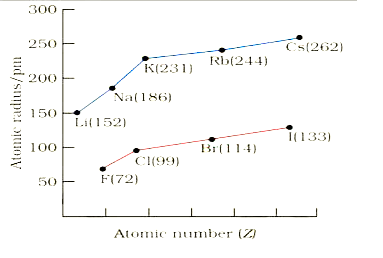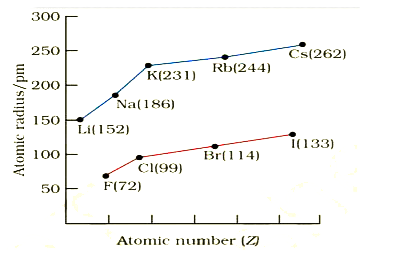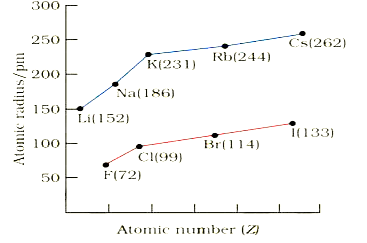From Be to Ba electropositive or metallic character
Increases
Decreases
Remains same
Cannot be predicted
The correct Answer is:A
Step by step video, text & image solution for From Be to Ba electropositive or metallic character by Chemistry experts to help you in doubts & scoring excellent marks in Class 11 exams.
Topper's Solved these Questions
- BOOK - NARAYNACHAPTER - S-BLOCK ELEMENTSEXERCISE - ALKALI EARTH METALS-CUQ(ANOMALOUS BEHAVIOR OF BE & ITS DIAGONAL RELATIONSHIP WITH AL)2videos
S-BLOCK ELEMENTS
- BOOK - NARAYNACHAPTER - S-BLOCK ELEMENTSEXERCISE - ALKALI EARTH METALS-CUQ(BIOLOGICAL IMPORTANCE OF CALCIUM AND MAGNESIUM IONS)4videos
S-BLOCK ELEMENTS
- BOOK - NARAYNACHAPTER - S-BLOCK ELEMENTSEXERCISE - CONCEPTUAL QUESTIONS(CHEMICAL PROPERTIES)10videos
S-BLOCK ELEMENTS
- BOOK - NARAYNACHAPTER - REDOX REACTIONEXERCISE - Exercise -4114videos
REDOX REACTION
- BOOK - NARAYNACHAPTER - SOLID STATEEXERCISE - LEVEL-V122videos
SOLID STATE
Similar Questions
Knowledge Check
- Question 1 - Select One
Metallic Character
The ability of an atom to donate electrons and form positive ion (cation) is known as electropositivity or metallic character. Down the group, metallic character increases due to increase in atomic size and across the period, from left to right electropositivity decreases due to decrease in atomic size.
Non-Metallic Character
The ability of an atom to accept electrons to form a negative ion (anion) is called non-metallic character or electronegativity. The elements having high electro-negativity have a higher tendency to gain electrons and form anion.Down the group, electronegativity decreases due to increase in atomic size and across the period, from left to right electronegativity increases due to decrease in atomic size

Hydrogen is placed along with Alkali metals in the modern periodic table though it shows non-metallic characterAas Hydrogen has one electron & readily loses electron to form negative ionBas Hydrogen can easily lose one electron like alkali metals to form positive ionCas Hydrogen can gain one electron easily like Halogens to form negative ionDas Hydrogen shows the properties of non-metals - Question 2 - Select One
Metallic Character
The ability of an atom to donate electrons and form positive ion (cation) is known as electropositivity or metallic character. Down the group, metallic character increases due to increase in atomic size and across the period, from left to right electropositivity decreases due to decrease in atomic size.
Non-Metallic Character
The ability of an atom to accept electrons to form a negative ion (anion) is called non-metallic character or electronegativity. The elements having high electro-negativity have a higher tendency to gain electrons and form anion. Down the group, electronegativity decreases due to increase in atomic size and across the period, from left to right electronegativity increases due to decrease in atomic size

Which of the following correctly represents the decreasing order of metallic character of Alkali metals plotted in the graph?ACs>Rb>Li>Na>KBK>Rb>Li>Na>CsCCs>Rb>K>Na>LiDCs>K>Rb>Na>Li - Question 3 - Select One
Metallic Character
The ability of an atom to donate electrons and form positive ion (cation) is known as electropositivity or metallic character. Down the group, metallic character increases due to increase in atomic size and across the period, from left to right electropositivity decreases due to decrease in atomic size.
Non-Metallic Character
The ability of an atom to accept electrons to form a negative ion (anion) is called non-metallic character or electronegativity. The elements having high electro-negativity have a higher tendency to gain electrons and form anion.Down the group, electronegativity decreases due to increase in atomic size andacross the period, from left to right electronegativity increases due to decreasein atomic size

Identify the reason for the gradual change in electronegativity in halogensdown the group.AElectronegativity increases down the group due to decrease in atomic sizeBElectronegativity decreases down the group due to decrease in tendency to lose electronsCElectronegativity decreases down the group due to increase in atomic radius/ tendency to gain electron decreasesDElectronegativity increases down the group due to increase in forces of attractions between nucleus & valence electrons
Electropositivity is the non-metallic character of an element.
View SolutionMetallic Character
The ability of an atom to donate electrons and form positive ion (cation) is known as electropositivity or metallic character. Down the group, metallic character increases due to increase in atomic size and across the period, from left to right electropositivity decreases due to decrease in atomic size.
Non-Metallic Character
The ability of an atom to accept electrons to form a negative ion (anion) is called non-metallic character or electronegativity. The elements having high electro-negativity have a higher tendency to gain electrons and form anion. Down the group, electronegativity decreases due to increase in atomic size and across the period, from left to right electronegativity increases due to decrease in atomic size

Which of the following has highest electronegativity?View SolutionMetallic Character
The ability of an atom to donate electrons and form positive ion (cation) is known as electropositivity or metallic character. Down the group, metallic character increases due to increase in atomic size and across the period, from left to right electropositivity decreases due to decrease in atomic size.
Non-Metallic Character
The ability of an atom to accept electrons to form a negative ion (anion) is called non-metallic character or electronegativity. The elements having high electro-negativity have a higher tendency to gain electrons and form anion. Down the group, electronegativity decreases due to increase in atomic size and across the period, from left to right electronegativity increases due to decrease in atomic size

Which of the following reason correctly justifies that “Fluorine (72pm) has smaller atomic radius than Lithium (152pm)”?View SolutionCorrect order of metallic character is :-
View SolutionThe correct of the metallic character is :
View Solution

